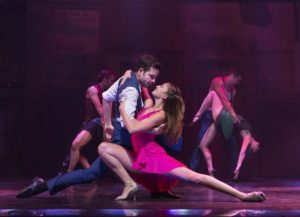Arrabal: A Story of Love and Politics Told through the Tango

Arrabal, now playing at the American Repertory Theatre in Cambridge in its U.S. début, premiered in Toronto in 2014. In its present state, it is a fascinating theatre experience, a political drama told without words via the tango and music. It is also an immersive show where some audience members, supposedly at a tango club in Buenos Aires, sit at tables downstage as well as on the orchestra floor, which had several rows of seats removed. In the first scene which takes place in the present spectators are invited to join the performers onstage for a tango lesson.
The joyous mood changes abruptly as the story begins. A projection announces that it is 1976, the year in which Isabel Peron’s government was overthrown by a right-wing junta. We meet Rodolfo (Julio Zurita), an endangered resistant, bringing his infant daughter to his mother who lives in a slum (arrabal in Spanish) outside Buenos Aires. He dances a tender tango with baby Arrabal (a word also associated with the tango) before putting her into the bassinet and leaving her a red scarf.
He goes to meet his friends at a tango club where they dance together in lieu of speaking before the joint is raided by junta thugs. Rodolfo is tortured in a scene painful to watch.
Much later we see Arrabal’s abuela (Marienella Massarotti) participating in the mothers and grandmothers’ silent weekly march at the Plaza de Mayo in Buenos Aires in an attempt to arouse the populace to action to help them find their loved ones. The women, garbed in housedresses, have their heads covered with white scarves, and wear pictures of their “desparecidos” in the hope that someone will recognize them.
Eighteen years after her father’s departure, a lovely, slender Arrabal (Micaela Spina) awakes in her father’s former bedroom holding the scarf he left her and dances a ballet-like piece. She is haunted by dreams of her father and longs to find out what happened to him. Although the junta has been replaced, the fate of the disappeared is still unknown. Arrabal receives a letter from Rodolfo’s old friend El Puma (Carlos Rivarola) inviting her to come to Buenos Aires where he operates a tango club. The club is on the shady side and at moments gives the appearance of a brothel. Arrabal’s innocence stands out, but bit by bit she adapts. Fortunately, she meets a decent man and they fall in love. The story line becomes pat from time to time.
Julio Zurita and Sergio Trujillo’s choreography is beautiful and exciting; the dancers graceful, strong, and sensual. Arrabal’s tangos project a feeling of competition, drama, and passion that is, judging by their reaction when I saw the play, enthralling for the audience. Trujillo, also the play’s director, staged it with verve and skill.
The pulsing music composed by Gustavo Santaolalla who won an Academy Award for his score for Brokeback Mountain is stirring. It is played by a five piece band Orquesta Bajofonderos led by Alejandro Kauderer, seated on a small balcony stage right. A few of their instruments are specific to South America. The musicians play the guitar, violin, double bass, ronroco or ten string mandolin, and bandeon, a kind of concertina. On occasion, they descend to the stage, particularly Kauderer, who plays the keyboards in addition to conducting.
It is an extremely colorful show. The female dancers are dressed in brightly-hued clinging costumes while Vincent Colbert’s constantly changing lighting design brings another dimension to the work as do Peter Nigrini’s projections.
Arrabal ends as it begins with audience members invited to tango onstage with the performers.
Arrabal continues at the American Repertory Theatre’s Loeb Drama Center until June 18, 2017.
Composer ………………………. Gustavo Santaolalla
Music …………………………… Bajofondo
Book …………………………….. John Weidman
Scenic Design …………………… Riccardo Hernandez
Costume Design …………………. Clint Ramos
Lighting Design …………………. Vincent Colbert
Projection Design …………………Peter Nigrini
Music Director ……………………Alejandro Kauderer
Choreographer …………………….. Julio Zurita
Director and Co-Choreographer …… Sergio Trujillo
Cast
Nicole ……………………….. Soledad Buss
Berta …………………………. Valeria Celurso
Juan ………………………….. Juan Cupini
Abuela …………………………Marianella Massarotti
El Puma ………………………. Carlos Rivarola
El Duende …………………….. Mario Rizzo
Arrabal …………………………Micaela Spina
Rodolfo ……………………….. Julio Zurita
Ensemble ……………………… Florencia Beltramo, Nicolas Cobos, Paola Jean Jean,
José Lugones, Analia Morales, Leonardo Pankow,
César Peral, Gabriel Ponce, Marcela Vespasiano